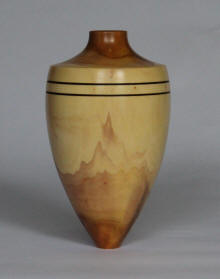|
Sandalwood
(Santalum lanceolatum)
Also known as: Plumbush, Northern Sandalwood
|
|

 Sandalwood is found all over Queensland on just about any type of country. Once you know what to look for, it just seems to be everywhere and is most
commonly seen as thick patches of small shrubs. It eventually grows to about 4 metres high with a trunk
about 150mm diameter though I know of a few at about 6 metres high with 200mm trunks (no - I won't tell you where!). Sandalwood is found all over Queensland on just about any type of country. Once you know what to look for, it just seems to be everywhere and is most
commonly seen as thick patches of small shrubs. It eventually grows to about 4 metres high with a trunk
about 150mm diameter though I know of a few at about 6 metres high with 200mm trunks (no - I won't tell you where!).
|



|


The leaves are often ragged and few as the insects love the stuff.
The flowers develop into a small red berry which is edible and very attractive to birds.
|
|

 I had my eye on this tree for some time and when I drove past and saw some lousy bugga had felled it,
I though I had better have a closer look. It was actually a few thousand lousy bugga's that had done the damage - white ants!
They had come up through a very small gallery in the heart of the tree to about 1 metre high and then
gone out and circled the tree just under the bark until it fell - like beavers of the insect family.
Very strange behaviour!
I had my eye on this tree for some time and when I drove past and saw some lousy bugga had felled it,
I though I had better have a closer look. It was actually a few thousand lousy bugga's that had done the damage - white ants!
They had come up through a very small gallery in the heart of the tree to about 1 metre high and then
gone out and circled the tree just under the bark until it fell - like beavers of the insect family.
Very strange behaviour!
|
|
 Being parasitic, the tree needs to grow very close to suitable host plants to develop the oil bearing, colourful heartwood.
I have been caught out cutting a tree with no host that had only a tiny core of heartwood no bigger or longer than your
finger - just odourless, yellowish sapwood which is still nice to work regardless. The cross section pictured
was growing in a tight thicket of Brigalow, hence the coloured heartwood, but alas, the grubs had found it too - for
the full length of the tree. Green or dry, Sandalwood is beautiful to turn, particularly when you hit the heartwood
because the aroma is glorious. It sands really well and finishes very nicely also except the sapwood does soak up
the finish a bit.
Being parasitic, the tree needs to grow very close to suitable host plants to develop the oil bearing, colourful heartwood.
I have been caught out cutting a tree with no host that had only a tiny core of heartwood no bigger or longer than your
finger - just odourless, yellowish sapwood which is still nice to work regardless. The cross section pictured
was growing in a tight thicket of Brigalow, hence the coloured heartwood, but alas, the grubs had found it too - for
the full length of the tree. Green or dry, Sandalwood is beautiful to turn, particularly when you hit the heartwood
because the aroma is glorious. It sands really well and finishes very nicely also except the sapwood does soak up
the finish a bit.
|
|
|
 An urn turned from a tree with virtually no heartwood or oil content - still lovely timber to work with.
An urn turned from a tree with virtually no heartwood or oil content - still lovely timber to work with.
|
 A goblet turned from a branch with very high oil content - the aroma is magnificent but unfortunately doesn't last very long.
A goblet turned from a branch with very high oil content - the aroma is magnificent but unfortunately doesn't last very long.
|



|
|














